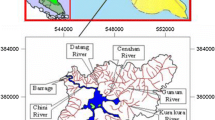Abstract
The concentrations and the distribution of organic matter in SLB (e.g. the outer part of Thale Sap Songkhla area) were examined during the period of September 1988 to September 1989. Organic matter in water samples were analyzed by gravimetry. Total organic matter and dissolved organic matter concentrations ranged from 74 to 7908 mg/L and from 23 to 7813 mg/L, respectively. Except for a set of observations which showed low concentrations during the flood season in November 1988, organic matter was regularly distributed throughout SLB. Domestic effluent and aquaculture are hypothesized as major sources of organic matter contamination. The levels of organic matter concentrations in SLB are significantly higher than would be expected for an area considered to be uncontaminated. The data also indicated a linear relationship between concentrations of suspended organic matter and suspended solids. This may be due to the organic matter associated with suspended solids.
Similar content being viewed by others
References
APHA-AWWA-WPCH: 1985, Standard Methods for the Examination of water and Wastewater, American Public Health Association, Washington D.C. 1268 pp.
Brown, S. W., Karickhoff, S. W., and Scott, T. A.: 1979, ‘Sorption of Hydrophobic Pollutants on Natural Sediments’, Water Res. 13, 241–248.
Buffle, J.: 1984, ‘The Natural Organic Substances and Their Metal Complexes in Aquatic Systems’. In H. Sigel (Ed.), Circulation of Metals in the Environment, Vol. 18 of the series Metal Ions in Biological Systems, Marcel Dekker, New York.
Burton, J. D., Moore, R. M., William, P. J. LeB, and Young, M. L.: 1979, ‘The Behaviour of Dissolved Organic Material, Iron and Manganese in Estuarine Mixing’, Geochim. Cosmochim. Acta. 43, 919–926.
Cutshall, N. H., Larsen, I. L., and Olsen, C. R.: 1982, ‘Pollutant-Particle Associations and Dynamics in Coastal Marine Environments: A Review’, Marine Chem. 11, 501–533.
Davies, B. E.: 1974, ‘Loss on Ignition as an Estimate of Soil Organic Matter’, Soil Soc. Am. Proc. 38, 150–151.
Feltz, H. R.: 1980, ‘Significance of Bottom Material Data in Evaluating Water Quality’. In R. A. Baker (Ed.) Contaminants and Sediments, Ann Arbor Science, Michigan.
Förstner, U., and Salomons, W.: 1984, ‘Metals in the Hydrocycle’, Springer Verlag, Berlin 349 pp.
Hahn, H. H., and Stumm, W.: 1970, ‘The Role of Coagulation in Natural Waters’, Am. J Sci. 268, 354–368.
John Taylors and Sons: 1985, ‘Songkhla Lake Basin Planning Study’, Sector Paper no. 23 and 55, John Taylors and Sons, Bangkok.
Kranck, K.: 1974, ‘The Role of Flocculation in the Transport of Particulate Pollutants in the Marine Environment’. In Proceedings of The International Conference on Transport of Persistent Chemicals in Aquatic Ecosystems, May 1974, Ottawa, Canada.
Liss, P. S. and Loder, T. C.: 1982, ‘The Role of Organic Matter in Determining the Surface Charge of Suspended Particles in Estuaries and Oceanic Waters’, Thalassia Jugoslavica 18, 433–447.
Loeb, G. I., and Niehof, R. A.: 1973, ‘Dissolved Organic Matter in Seawater and the Electric Charge of Immersed Surfaces’, J. Mar. Res. 32, 5–12.
Meteorological Department: 1988, ‘Floods in the Southern Part During 13–23 November 1988’, Division of Analysis and Hydrological Forcasting 111 pp.
Mantoura, R. F. C., and Woodward, E. M. S.: 1983, ‘Conservative Behaviour of Riverine Dissolved Organic Carbon in the Severn Estuary: Chemical and Geochemical Implications’, Geochim. Cosmochim. Acta 47, 1293–1309.
Morel, F. M. M.: 1983, Principles of Aquatic Chemistry, John Wiley and Sons 446 pp.
Morgan, J. J., and Stumm, W.: 1981, Aquatic Chemistry, 2nd ed., John Wiley and Sons 780 pp.
Nissenbaum, A., and Swaine, D. J.: 1976, ‘Organic Matter-Metal Interactions in Recent Sediments: The Role of Humic Substances’, Geochim. Cosmochim. Acta. 40, 809–816.
Perdue, E. M., and Reuter, J. H.: 1977, ‘Importance of Heavy Metal-Organic Matter Interactions in Natural Waters’, Geochim. Cosmochim. Acta. 41, 325–334.
Saengsakul, P.: 1984, ‘Organic Carbon in Sediment of Songkhla Lake’, Technical Paper no. 2/1985, National Institute of Coastal Aquaculture, Songkhla, 6 pp.
Williams, P. J.: 1975, ‘Biological and Chemical Aspects of Dissolved Organic Material in Sea Water’. In J. P. Riley and G. Skirrow (Ed.), Chemical Oceanography, Vol. 2, Academic Press, London.
Zafirion, O. C., Zepp, R. G., Zika, R. D., and Joussot-Dubien: 1984, J. Environ. Sci. Technol. 18, 358A-371A.
Author information
Authors and Affiliations
Rights and permissions
About this article
Cite this article
Sherdshoopongse, P., Thapornsawati, S. & Kwankaew, J. The distribution of organic matter in songkhla lake basin (SLB). Environ Monit Assess 19, 457–467 (1991). https://doi.org/10.1007/BF00401333
Issue Date:
DOI: https://doi.org/10.1007/BF00401333




